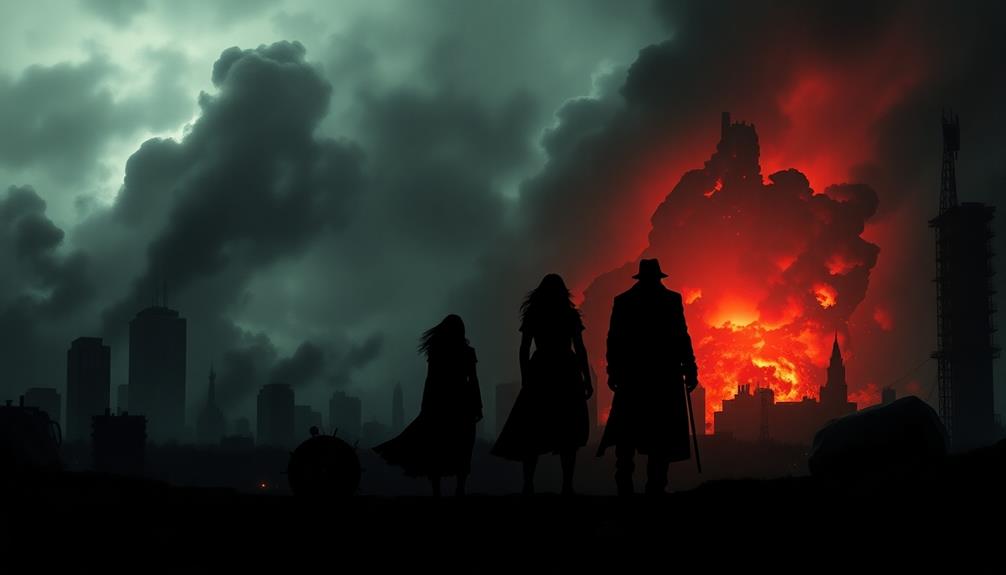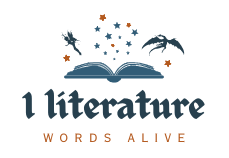Stephen King, the renowned master of horror, wrote *The Stand*. This epic novel paints a gripping picture of humanity's battle between good and evil in a world devastated by a deadly pandemic. As you journey through the story, you'll encounter memorable characters like Mother Abagail, representing hope, and Randall Flagg, symbolizing chaos. King's complex themes and moral dilemmas reveal the fragility of society and the human spirit's resilience. If you want to uncover more about its rich narrative and the impact it's had over the years, there's much more to discover beyond this introduction.
Overview of The Stand
*The Stand* presents a chilling vision of a post-apocalyptic world where a deadly influenza strain, Captain Trips, decimates 99.4% of humanity in just a month.
You're thrust into a stark landscape, witnessing the aftermath of a pandemic that forces survivors to confront the essence of humanity itself. The narrative intricately explores the themes of good versus evil, as the remnants of society split into two factions. This division leads to a compelling examination of moral complexities, as diverse characters grapple with their roles in the face of overwhelming adversity and chaos, showcasing how their journeys reflect deeper character development.
On one side, you find the benevolent Mother Abagail, a guiding figure in Boulder, Colorado, who embodies hope and moral integrity.
On the other, the malevolent Randall Flagg rules in Las Vegas, promoting chaos and fear. This clash between light and darkness becomes central to the story, showcasing how human resilience can thrive even in the bleakest conditions.
As you navigate through over 1,152 pages of rich storytelling and character development, you're not just reading about survival; you're engaging with profound moral dilemmas.
The struggle between Mother Abagail and Randall Flagg ultimately asks you to reflect on what it means to be human in a world stripped of its societal norms.
Plot Summary
In "The Stand," you witness the aftermath of a devastating pandemic that wipes out most of humanity.
As immune survivors like Stuart Redman band together in Boulder, they face not only the chaos of a collapsed society but also the fierce conflict with Randall Flagg's oppressive regime in Las Vegas.
This struggle highlights the stark contrasts between good and evil, showcasing the resilience of the human spirit in the face of overwhelming odds.
Much like the courageous acts of resistance during World War II, the characters in the novel embody an indomitable spirit against tyranny, demonstrating that collective action can be a powerful force for change.
Global Pandemic Impact
A devastating global pandemic unfolds in Stephen King's 'The Stand', triggered by a weaponized strain of influenza called Captain Trips. Within just a month, this deadly virus wipes out approximately 99.4% of the world's population, leading to a rapid societal collapse.
As chaos reigns, you witness communities disintegrating, and the remnants of humanity grappling with loss and fear. Survivors, like Stuart Redman, emerge as pivotal figures in this new reality, traversing the treacherous landscape of a post-apocalyptic world.
You see how personal tragedies shape these characters, as they grapple with the enormity of their circumstances. The struggle for survival becomes a brutal test of resilience, as the immune characters band together, forming alliances to combat the overwhelming despair.
The impact of the global pandemic is felt deeply, as societal norms crumble and the fabric of civilization unravels. In this dark narrative, King vividly illustrates the fragility of society and the human spirit's capacity to endure.
The aftermath sets the stage for the upcoming conflict, but first, you must witness the harrowing journey of survival amidst the devastation.
Faction Conflicts Explored
After the dust settles from the catastrophic pandemic, two distinct factions emerge, each vying for the future of humanity.
On one side, you find Mother Abagail and her followers in Boulder, Colorado, who represent hope, community, and the selfless ideals of rebuilding society. They embody the essence of good, working together to create a stable environment amidst chaos.
On the other side stands Randall Flagg, who establishes a totalitarian regime in Las Vegas, embodying chaos and authoritarianism. His faction thrives on manipulation and fear, showcasing the darker side of human nature.
The faction conflicts between these two groups illustrate a profound struggle between good and evil. As the narrative unfolds, significant moments arise that reveal the stark ideological differences between Abagail's cooperative spirit and Flagg's oppressive tactics.
Tensions escalate as both factions prepare for an inevitable confrontation, leading to moral dilemmas and character development. These conflicts force individuals to confront their beliefs and choices in extreme circumstances, ultimately reflecting the broader battle for humanity's future.
In this post-apocalyptic landscape, the choices you make resonate with the age-old struggle between light and darkness.
Major Characters

In "The Stand," you'll meet a range of characters who embody the struggle between good and evil.
Protagonists like Stuart Redman and Frannie Goldsmith face their own trials, showcasing resilience and hope in a bleak world. Their journeys reflect themes of personal growth through challenges that resonate with the human spirit.
Meanwhile, Randall Flagg's manipulative influence poses significant challenges, pushing each character toward growth and transformation.
Protagonists and Their Struggles
Resilience shapes the journey of the major characters in Stephen King's 'The Stand,' each facing unique struggles in a shattered world. At the forefront is Stuart Redman, an immune survivor whose leadership skills guide others through the chaos. His determination is tested as he confronts the harsh realities of a post-apocalyptic landscape.
Alongside him, you'll find Frannie Goldsmith, a pregnant college student grappling with her fears and hopes for the future. Her struggle represents the fight for survival and the possibility of new beginnings amid despair.
Mother Abagail, the wise 108-year-old woman, serves as the spiritual leader of the Boulder community. She embodies hope and stands in stark contrast to Randall Flagg, the charismatic antagonist who thrives on chaos and authoritarianism. While Mother Abagail rallies the forces of good, Flagg manipulates and controls his followers in Las Vegas, presenting a dark vision of society's potential.
Nick Andros, a deaf-mute drifter, also plays a crucial role, showcasing innate leadership and strong moral convictions.
These protagonists illuminate the diverse ways individuals contribute to the survivor community, each battling their personal struggles against a backdrop of overwhelming adversity.
Antagonists and Their Influence
Chaos reigns in Stephen King's *The Stand*, primarily through the character of Randall Flagg, the embodiment of malevolence. Flagg's dark charisma attracts followers, using fear and manipulation to establish a totalitarian regime in Las Vegas. His supernatural abilities deepen the psychological struggle among the survivors, showcasing the battle of good versus evil.
- Flagg's influence leads to betrayal and violence, shaping the narrative's moral dilemmas.
- Nadine Cross, a teacher, becomes ensnared in Flagg's web, illustrating the seductive nature of authoritarianism.
- Mother Abagail stands in stark contrast to Flagg, representing hope and moral leadership.
- The ideological conflict between Flagg and Abagail underscores the story's themes of light and darkness.
- Flagg's actions ripple through the characters, driving them to confront their own moral choices.
Through the lens of these antagonists, King explores the depths of human nature, revealing how fear can distort morality. The tension between Flagg and Mother Abagail not only propels the plot but also compels you to reflect on the choices you might face in a world teetering on the brink of chaos.
Character Arcs and Growth
Evolving through adversity, the major characters in *The Stand* commence on transformative journeys that highlight their growth and resilience. Stuart Redman's character development transforms him from a simple Texas everyman into a resilient leader, showcasing compassion and strength amid societal collapse. As he faces new moral dilemmas, his journey reflects the complexities of human nature.
Mother Abagail serves as a spiritual guide, gathering survivors and embodying hope, all while wrestling with her faith and the burdens of leadership. Her arc emphasizes the importance of a strong moral compass in a chaotic world.
Conversely, Randall Flagg illustrates the seductive nature of power and chaos, manipulating others and building a totalitarian regime, ultimately leading to his own undoing through the darkness he promotes.
Frannie Goldsmith undergoes a significant transformation, evolving from a frightened young woman into a beacon of hope, confronting her fears and embracing motherhood amidst the apocalypse.
Finally, Nick Andros, despite being deaf-mute, emerges as a strong moral figure, demonstrating leadership and determination in steering through the challenges of survival and the intricacies of human relationships.
These character arcs offer profound insights into resilience and the human spirit.
Themes and Motifs
In Stephen King's "The Stand," the clash between good and evil serves as a powerful backdrop, driving the narrative and shaping the characters' journeys. You witness this dynamic primarily through the contrasting figures of Mother Abagail, who symbolizes hope, and Randall Flagg, who embodies manipulation and fear.
This conflict reveals the moral choices individuals must confront in a post-apocalyptic world, reminiscent of the resilience displayed by characters like Liesel Meminger in Nazi Germany's oppressive era.
The themes and motifs in the novel are rich and multifaceted:
- Good versus evil: The eternal struggle influences every character's decisions and fate.
- Human resilience: Survivors demonstrate remarkable strength as they navigate personal tragedies and societal challenges.
- Societal collapse: The rapid deterioration of civilization highlights the fragility of societal structures.
- Leadership complexities: Characters display varying leadership styles, from altruism to authoritarianism, reflecting their personal ethics.
- Spirituality: Mother Abagail's faith stands in stark contrast to Flagg's fear tactics, emphasizing the importance of belief in overcoming adversity.
Through these themes, King invites you to reflect on the nature of humanity and the choices that define our existence.
Publication History

When you look at the publication history of 'The Stand,' you'll notice it was first released in 1978 as an abridged version, set in 1980.
The novel explores themes of social class and personal growth, similar to Dickens' works.
The 1990 expanded edition restored over 400 pages, making it King's longest work at 1,152 pages.
With over 4.5 million copies sold and critical acclaim, this novel has certainly made its mark in the literary world.
Initial Publication Details
Originally published in 1978, Stephen King's "The Stand" made its debut in an abridged format, laying the groundwork for future expansions. This gripping novel quickly captured the attention of readers and critics alike, marking a significant milestone in King's career.
Here are some key publication details you might find interesting:
- The first paperback edition, released in 1980, altered the setting date from 1980 to 1985.
- In 1990, an uncut version was published, restoring over 400 pages of original text.
- This 1990 edition became the longest book by Stephen King, totaling 1,152 pages.
- "The Stand" reached #1 bestseller status, selling approximately 4.5 million copies.
- The novel's impact on the literary market is undeniable, solidifying King's reputation as a master storyteller.
These initial publication details set the stage for the enduring legacy of "The Stand."
Whether you're revisiting the novel or diving into it for the first time, understanding its publication history adds depth to your reading experience.
Expanded Editions Overview
The evolution of "The Stand" through its expanded editions highlights Stephen King's commitment to enhancing his narrative. Originally published in 1978, the novel appeared in an abridged form, which meant some details were lost. The first paperback release in 1980 adjusted the setting date to 1985, altering some contextual elements that readers experienced.
In 1990, King masterfully restored over 400 pages of text in the notably expanded edition. This version not only added depth to the story but also solidified "The Stand" as King's longest book at 1,152 pages. Readers were finally able to grasp the full scale of his vision, enriching their understanding of the characters and their struggles in a post-apocalyptic world.
Additionally, the Deluxe Coffin Box edition catered to collectors and die-hard fans, featuring 1,250 numbered and 52 lettered copies. This limited release guaranteed that the expanded edition reached a dedicated audience, allowing them to appreciate the thorough nature of King's work.
Sales and Reception
Stephen King's "The Stand" quickly climbed to popularity upon its release, enchanting readers with its gripping narrative and intricate characters. Originally published in 1978 in an abridged format, it gained even more recognition with the uncut edition in 1990, which restored over 400 pages of content. This expanded version became King's longest work, stretching to an impressive 1,152 pages.
The novel's success is evident in its remarkable sales figures and accolades:
- Over 4.5 million copies sold
- Achieved bestseller status shortly after release
- Received critical acclaim, appearing on numerous "best books" lists
- Nominated for the World Fantasy Award for Best Novel in 1979
- Ranked number 53 in the BBC's The Big Read poll in 2003
The first paperback edition, released in 1980, cleverly updated the setting from 1980 to 1985, making it resonate with contemporary readers.
With its blend of horror and humanity, "The Stand" continues to captivate audiences, solidifying its place as a classic in American literature.
Critical Reception
Upon its release, *The Stand* garnered significant critical acclaim, earning a nomination for the World Fantasy Award for Best Novel in 1979. This recognition was just the beginning; the novel quickly achieved #1 bestseller status, selling over 4.5 million copies and solidifying its place in popular literature.
Critics praised Stephen King's masterful storytelling and intricate character development, which allowed readers to deeply connect with the diverse cast. The novel's exploration of human nature and societal collapse resonates with themes found in classic sci-fi epics, making it a compelling read for fans of the genre.
The 1990 uncut edition of *The Stand* further enhanced its reputation, as it restored over 400 pages of material, enriching the narrative and providing even more depth to the characters. This version was particularly well-received, showcasing how King's ability to weave complex themes into his writing resonated with both readers and critics alike.
Despite its success, the adaptations of *The Stand* sparked varied critical reception. The 1994 television miniseries and the 2020 miniseries on CBS All Access each approached the source material differently, highlighting the complexity and enduring appeal of King's original work.
Adaptations in Film

While many fans enthusiastically anticipated adaptations of *The Stand*, the journey from page to screen has produced a mix of interpretations, each offering a unique lens on King's expansive narrative.
The first adaptation, a television miniseries that aired on ABC in 1994, featured a cast including Gary Sinise as Stuart Redman and Molly Ringwald as Frannie Goldsmith. Although it received mixed reviews, it was praised for its faithful representation of the novel's core themes, much like the complexities found in the character dynamics of the love triangle in *Gone With the Wind*.
In December 2020, a new miniseries premiered on CBS All Access, reimagining King's story for a contemporary audience. This version introduced a new cast, including James Marsden and Whoopi Goldberg, and aimed to modernize certain elements.
Key aspects of these adaptations include:
- The 1994 miniseries remains a cult classic.
- The 2020 adaptation explores more diverse character arcs.
- Both adaptations have expanded The Stands reach to new generations.
- Fan reactions showcase a blend of nostalgia and modern appreciation.
- Each adaptation has sparked discussions about the themes of survival and morality.
These adaptations have solidified The Stands place in popular culture, continually engaging Stephen King's loyal fanbase.
Comic Book Series
Building on the adaptations of *The Stand*, the comic book series offers a fresh visual take on King's apocalyptic tale. Published by Marvel Comics from 2008 to 2012, this adaptation, crafted by writer Roberto Aguirre-Sacasa and featuring artwork by Mike Perkins and Laura Martin, breathes new life into the original story.
The graphic novel format allows for the exploration of complex themes and narratives, much like historical fiction that highlights empowering narratives and themes of resilience and strength in women. The comic book series not only stays true to King's vision but also expands certain plot points and investigates deeper into the characters' backstories that the novel left unexplored.
This approach allows readers to connect with the characters on a different level while experiencing the gripping narrative in a graphic novel format.
Fans and critics alike praised the series for its faithful yet innovative representation of the story, which helped solidify *The Stand*'s legacy. By combining stunning visuals with compelling storytelling, the comic book adaptation introduced a new audience to King's universe, ensuring that the tale of survival and humanity resonates across various mediums.
Cultural Impact

How has *The Stand* shaped our cultural landscape? Stephen King's post-apocalyptic horror novel has left an indelible mark on society, with its exploration of good versus evil resonating through various forms of media. The themes of societal collapse resonate strongly, especially in times of global crises, making it relevant even today.
Consider these aspects of its cultural significance:
- Adaptations, including a 1994 miniseries and a 2020 CBS All Access version, showcase its timeless appeal.
- A Marvel comic book series from 2008 to 2012 expanded its narrative universe, introducing it to new fans.
- It frequently appears on lists of best horror and post-apocalyptic novels, solidifying its status as a masterpiece.
- Musical references in songs by bands such as Metallica and Anthrax highlight its influence on popular culture.
- The ongoing discussions about its themes reveal how it encourages reflection on morality and human nature.
Through these avenues, The Stand continues to inspire, provoke thought, and entertain, cementing Stephen King's legacy as a critical voice in literature. Its cultural impact remains profound, inviting each generation to explore its timeless narrative.
Author's Inspiration
Stephen King ignited his creativity for *The Stand* through a mix of real-world events and literary influences. A chemical spill in Utah sparked his initial idea, prompting him to explore themes of catastrophe and survival. You can see how societal chaos inspired him, especially when he drew parallels to the case of Patty Hearst, which highlighted the complexities of human behavior in extreme circumstances.
King also took cues from George R. Stewart's *Earth Abides*, a novel that reflects on the aftermath of a plague and its impact on civilization. This literary backdrop helped shape his vision of a post-apocalyptic world.
In *Danse Macabre*, King expressed his desire to create an American fantasy epic akin to *The Lord of the Rings*, focusing on the classic battle between good and evil.
Mother Abagail emerges as a beacon of hope and moral clarity, representing the themes of good in the face of darkness. In contrast, Randall Flagg embodies chaos and manipulation, serving as a powerful antagonist who reflects the darker aspects of human nature.
Together, these elements weave a complex narrative that captivates and challenges readers.
Conclusion
In the end, *The Stand* isn't just a story about good versus evil; it's a mirror reflecting our own struggles and resilience. As you close the pages, consider what you'd do in a world torn apart by chaos. Would you join the forces of light or darkness? Stephen King's epic journey leaves you pondering your own choices, making it a timeless tale that resonates long after the last word is read. Are you ready to take a stand?



